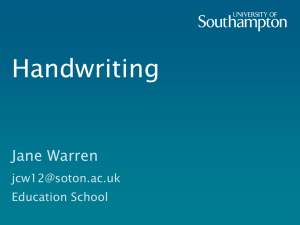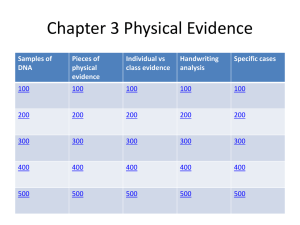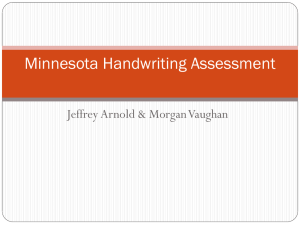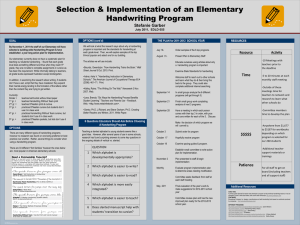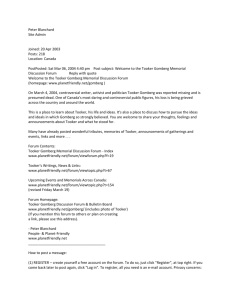Introduction to Handwriting Analysis
advertisement
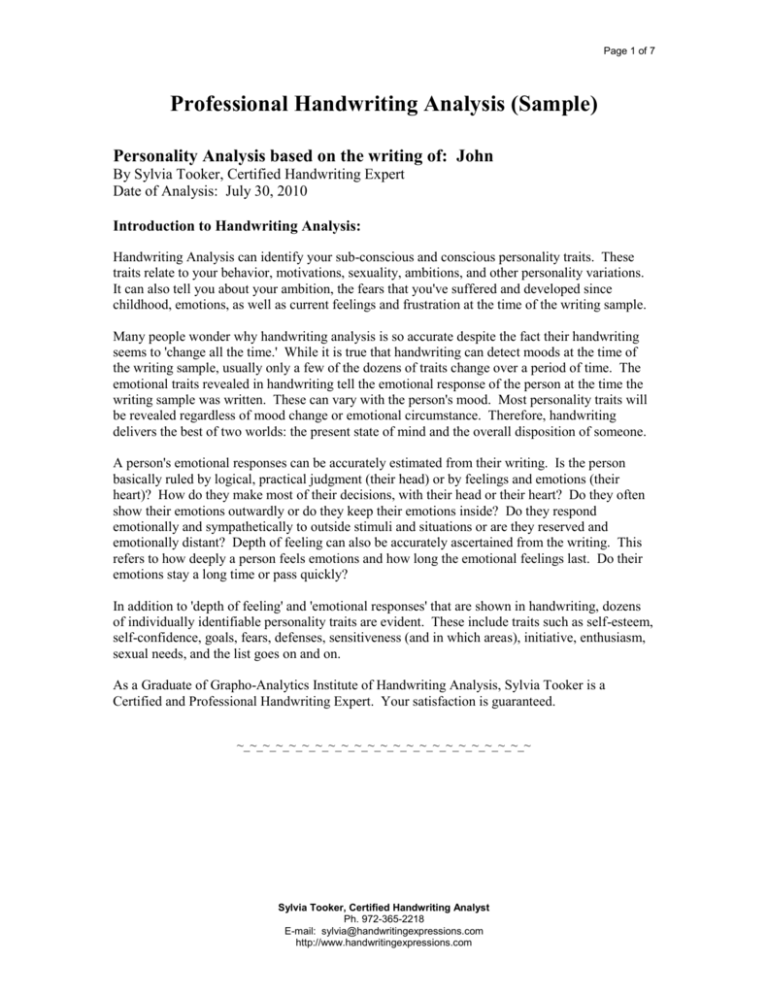
Page 1 of 7 Professional Handwriting Analysis (Sample) Personality Analysis based on the writing of: John By Sylvia Tooker, Certified Handwriting Expert Date of Analysis: July 30, 2010 Introduction to Handwriting Analysis: Handwriting Analysis can identify your sub-conscious and conscious personality traits. These traits relate to your behavior, motivations, sexuality, ambitions, and other personality variations. It can also tell you about your ambition, the fears that you've suffered and developed since childhood, emotions, as well as current feelings and frustration at the time of the writing sample. Many people wonder why handwriting analysis is so accurate despite the fact their handwriting seems to 'change all the time.' While it is true that handwriting can detect moods at the time of the writing sample, usually only a few of the dozens of traits change over a period of time. The emotional traits revealed in handwriting tell the emotional response of the person at the time the writing sample was written. These can vary with the person's mood. Most personality traits will be revealed regardless of mood change or emotional circumstance. Therefore, handwriting delivers the best of two worlds: the present state of mind and the overall disposition of someone. A person's emotional responses can be accurately estimated from their writing. Is the person basically ruled by logical, practical judgment (their head) or by feelings and emotions (their heart)? How do they make most of their decisions, with their head or their heart? Do they often show their emotions outwardly or do they keep their emotions inside? Do they respond emotionally and sympathetically to outside stimuli and situations or are they reserved and emotionally distant? Depth of feeling can also be accurately ascertained from the writing. This refers to how deeply a person feels emotions and how long the emotional feelings last. Do their emotions stay a long time or pass quickly? In addition to 'depth of feeling' and 'emotional responses' that are shown in handwriting, dozens of individually identifiable personality traits are evident. These include traits such as self-esteem, self-confidence, goals, fears, defenses, sensitiveness (and in which areas), initiative, enthusiasm, sexual needs, and the list goes on and on. As a Graduate of Grapho-Analytics Institute of Handwriting Analysis, Sylvia Tooker is a Certified and Professional Handwriting Expert. Your satisfaction is guaranteed. ~_~_~_~_~_~_~_~_~_~_~_~_~_~_~_~_~_~_~_~_~_~_~ Sylvia Tooker, Certified Handwriting Analyst Ph. 972-365-2218 E-mail: sylvia@handwritingexpressions.com http://www.handwritingexpressions.com Page 2 of 7 The following written personality analysis was written in person by Sylvia Tooker. Following are the results of the Analysis: John is highly responsive to emotional experiences. He is ruled by his heart rather than led by logic. He is an expressive person. He outwardly shows his emotions. When his emotions are in control, he may be impulsive and act before he thinks. He can be impatient if anything threatens to slow him down. Because he is sensitive to his surroundings, John will experience a variety of moods from highs to lows and everything in between. Like a sponge, he will absorb the atmosphere around him and be influenced by it. Because of his highly responsive nature, John is better able to understand the emotions and needs of others. When convincing him to buy a product or accept an idea, a heart rendering story could mean a great deal to him. He puts himself in the same situation as the person in the story, yet he will not buy or accept anything that seems overly impractical or illogical. Diplomacy is one of John's best attributes. He has the ability to say what others need to hear in sensitive situations. He can have tact with others. He has the ability to state things in such a way as to not offend someone else. He can disagree without being disagreeable. John is also sarcastic. This is a defense mechanism designed to protect his ego when he feels frustrated, irritated or hurt. He pokes people harder than he gets poked. These sarcastic remarks can be very funny. They can also be harsh, bitter, and caustic at the same time. John has an over-awareness of himself. He often feels self-conscious. He fears ridicule, therefore he is careful not to place himself in a position where he would make a fool of himself in front of others. He wonders what people will think if he acts in a certain manner. When encountering a new group of people, John may stay on the sidelines until he has the people categorized, or he may behave in a positive attention getting manner to assure people think good thoughts about him from the start. John generally has high self-confidence. He trusts his ability to achieve his goals. He will set high goals and look to the future when making them. He is willing to take risks. That doesn't mean he is reckless; he just doesn't have to know exactly how he will accomplish a goal before he begins because he knows he'll figure it out along the way. Yet his levels of self-esteem and confidence vary, indicating that he suffers from doubts and fears in some, but not all, areas of his life. Some people are confident in their careers Sylvia Tooker, Certified Handwriting Analyst Ph. 972-365-2218 E-mail: sylvia@handwritingexpressions.com http://www.handwritingexpressions.com Page 3 of 7 yet experience difficulty in personal relationships, or vice versa. When confidence is lacking, John will delay taking action and settle for less than he desires and deserves. John has drive and determination. He can set his mind on a goal and is determined to achieve it. He usually does. With all that drive and energy, John may attempt to do too much at once. He will over commit and end up with too many 'irons in the fire.' At the time of the writing, John is experiencing some stress in his life. He is maintaining his self-control, enabling him to proceed with his plans while experiencing difficulties. John is sometimes over-aware of what others think about him. He is slightly sensitive to criticism. He takes compliments and also criticisms to heart. He sometimes worries what others might think about him. He may go out of his way to make people like him. A single sincere compliment can really make his day! John is an independent thinker. He does not believe everything he has been taught or told. He will determine his own truths and live according to his beliefs. John can be secretive when it comes to sharing information with others. If he has information that he doesn't think others need to know, he can keep that information to himself. John can be stubborn. Once he makes up his mind, others will have difficulty getting him to change it. John will also stand firm on his beliefs. He is not afraid to speak up in the face of conflict. He can be argumentative at times. John is slow to trust. While he can socially get along with all types of people, he is selective about who he lets into his close circle of trusted friends and confidants. John will be candid and direct when expressing his opinion. He will tell people what he thinks if they ask for it, whether they like it or not. So, if they don't really want his opinion, don't ask for it! Likewise, John prefers that people be direct and to the point when communicating with him. He does not like when people 'beat around the bush' and waste his time with nonsense. He appreciates efficiency and likes to get to the bottom line. John has an interest in new activities. He may find himself getting bored and will seek something new to gain his interest. He needs variety in his life. Sylvia Tooker, Certified Handwriting Analyst Ph. 972-365-2218 E-mail: sylvia@handwritingexpressions.com http://www.handwritingexpressions.com Page 4 of 7 John has the ability to move from one thought pattern to another fluently and effectively. He can keep track of several thought patterns at once and has the communication skills needed to verbalize each one. Changing subjects or direction in the middle of a conversation does not upset him; he can handle it. John's fluid thinking enhances his ability to multi-task. He can easily switch from one activity to another and back again. Because of his constantly moving thoughts, John's mind can move so swiftly that he loses track of them. He can be scattered or forgetful at times. If his mind is active, he may be unable to turn off his thoughts at night causing a loss of sleep. John has a desire for knowledge and can be willing to learn. There are times when John skims only the surface in his thinking. He may prefer that others tend to the details so he can get on with what he would rather be doing. John sometimes procrastinates when faced with unpleasant tasks. This may cause him to hold back or be lazy about doing things that will improve his life. It can get him into unnecessary trouble. John is drawn to challenges. He doesn't always do things the easy way. He is attracted to situations and people that test his abilities. He is not afraid to tackle difficult tasks. If things or people are too easy to figure out, he loses interest and will seek the next challenge. John has the ability to 'always look on the bright side of life.' Even when things don't look good, he will find something positive in the situation. This is a pleasant attitude and he can be described as an optimistic person. ~_~_~_~_~_~_~_~_~_~_~_~_~_~_~_~_~_~_~_~_~_~_~ *SIGNATURE* NOTE: A signature is a person's symbol, like a logo. Unlike the rest of a person's handwriting which shows who a person 'really is,' a signature expresses who the writer wants the world to think he is. It indicates how a person feels about himself relative to the world around him. A signature that is written in a different manner than the rest of a person's writing hints that the writer is attempting to make a public impression that is different than who he is in private. Sylvia Tooker, Certified Handwriting Analyst Ph. 972-365-2218 E-mail: sylvia@handwritingexpressions.com http://www.handwritingexpressions.com Page 5 of 7 John's signature resembles the rest of his writing, so we know that what you see is what you get. His public persona is close to who he is in private. He is generally comfortable with his place in the world. NOTE: The first name of a signature relates to a person's unique identity. The last name relates to the family identity, or in the case of a married woman who takes her husband's name, it will relate to him and/or his family. The size of John's first and last names are balanced, indicating that he is has no major issues with his identity. However, his signature does include his middle name and it is underlined, so we know he is drawing attention to something he considers important about his identity that is not part of the usual first name/last name recognition. He has a strong desire to be known for what is generally hidden in most people, things that make him unique. The size of his middle name is the same as his first and last names, so he is merely adding additional information to them rather than eliminating aspects of them. He is clearly establishing how he wants to be known by the public. ~_~_~_~_~_~_~_~_~_~_~_~_~_~_~_~_~_~_~_~_~_~_~ *GRAPHO-THERAPY* The following suggestions for John are based on scientific research and represent years of studies. Practice each writing change at least three pages a day until it becomes habit. (This will usually take about 30 days.) If you have more than one suggested change, then work on one until it becomes a habit and then start on the next one. It is not recommended to change all the traits at one time; it is proven more effective one at a time. Practice the changes daily. ~_~_~_~_~_~_~ One of the best steps to a successful and happy life is a high self-esteem. Raising your selfconfidence will help you tremendously. You need to feel more self-confidence. One way to achieve this is through a simple change in your handwriting. This trait is located in the lower-case letter 't' and you will increase your confidence through changing the way you form this letter. Each time you make a letter 't', from now on, you will cross the 't' at the top of the stem. It may feel uncomfortable at first, but you will get used to it. Do not change any other aspects of your 't' without consultation. Merely move the t-bar from the lower part of the stem to the top of the stem. Once this stroke becomes a habit, about thirty days, you will notice a change. You will have more self confidence and believe you deserve better than you are now receiving. You will be able Sylvia Tooker, Certified Handwriting Analyst Ph. 972-365-2218 E-mail: sylvia@handwritingexpressions.com http://www.handwritingexpressions.com Page 6 of 7 to make a change without the fear that things might get worse. This will change your outlook on life: more self-esteem and a higher self-image. This way: ~_~_~_~_~_~_~ An adjustment that can change your life is eliminating your habit of procrastination. To do just that you will have to concentrate on the way you write your letter 't'. From now on, cross the t-bar perfectly centered and balanced on the stem of the 't'. Do not cross it more on the left side or the right side. If you do this for about thirty days, thus becoming a habit, you will be more of a selfstarter and eliminated procrastination from your life! Center that t-bar. This way: ~_~_~_~_~_~_~ These suggestions are based on the science of Grapho-Therapy. If your personality can be deduced from your handwriting, which we hope we have proven to you, then doesn't it make sense that that your writing can form your personality? Research and double blind studies prove its accuracy and effectiveness. Begin making the suggested writing changes immediately. The most effective way is to practice three pages per day or until the changes are a habit. What have you got to lose? ~_~_~_~_~_~_~_~_~_~_~_~_~_~_~_~_~_~_~_~_~_~_~ I sincerely hope you enjoyed the analysis and that you decide to integrate the grapho-therapeutic suggestions into your script. If you practice the writing changes at least a page or two each day, I guarantee that you will experience a positive change in your personality. Sylvia Tooker, Certified Handwriting Analyst Ph. 972-365-2218 E-mail: sylvia@handwritingexpressions.com http://www.handwritingexpressions.com Page 7 of 7 This concludes the personality analysis based upon the provided writing sample. This analysis represents an accurate description of the personality traits that were evident in writing at the time the sample was written, however, it was not designed to precisely specify every facet of intricate personality. Personalities are an intangible fascination of the mind. This analysis is therefore subject to syntax and grammatical comprehension. I have used the context, word patterns, and vocabulary words understood by the majority of the population. This particular written analysis is extremely accurate at the time and date of the writing sample, but, is not intended for use as a factual representation in a court of law or otherwise. The use of this information is solely at the discretion of the owner. Thank you for allowing me the opportunity to analyze handwriting for you. I take great pride in my work and customer satisfaction. If you have any questions or comments, please write or call me. By now, you realize that you can use handwriting analysis to reveal information about all your friends, acquaintances, business associates, and yourself. It is a valuable tool that is inexpensive and accurate. I look forward to analyzing your next handwriting sample. Best Regards, Sylvia Tooker Certified Handwriting Expert Sylvia Tooker, Certified Handwriting Analyst Ph. 972-365-2218 E-mail: sylvia@handwritingexpressions.com http://www.handwritingexpressions.com

